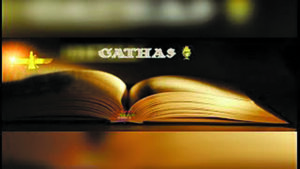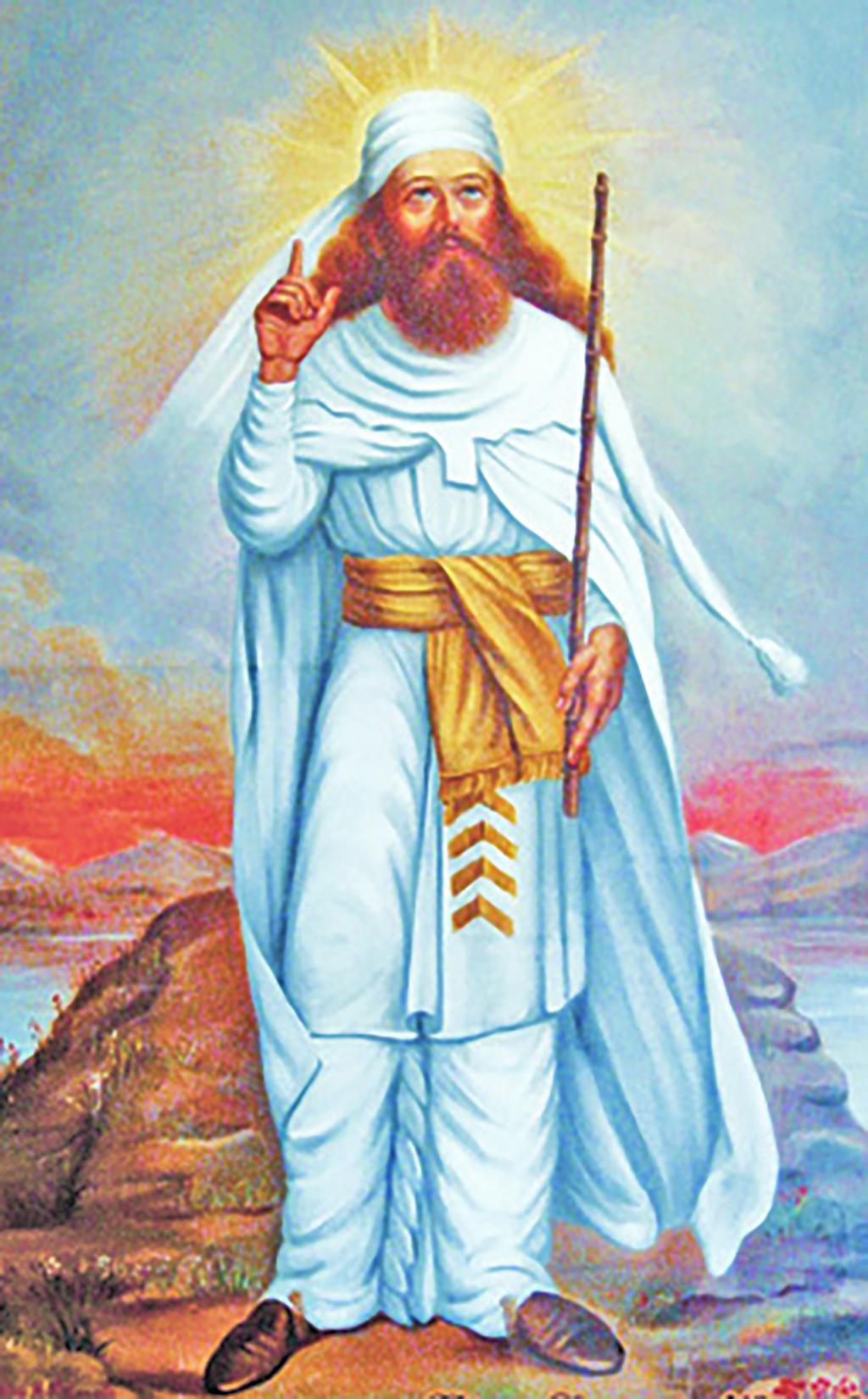The Gatha, consist of seventeen hymns composed by Asho Zarathushtra. Thsey are arranged into five groups based on their meter:
Ahunavaiti Gatha (Yasna 28 to Yasna 34)
Ushtavaiti Gatha (Yasna 43 to Yasna 46)
Spentamainyush Gatha (Yasna 47 to Yasna 50)
Vohukhshathra Gatha (Yasna 51)
Vahishtoishti Gatha (Yasna 53).
 The Gatha speak of the twin mentalities and choices we all must make using our sucha managha or “Illuminated mind”. In the Gatha, Zarathushtra says: “I will speak of the Spirits Twain at the first beginning of Life, of whom the Holier Spake thus to the wicked one: Never shall our minds harmonize, nor our doctrines; neither our aspirations, nor yet our beliefs; neither our words nor yet our actions.” This elaborates the ethical duality we observe in this world and in our lives.
The Gatha speak of the twin mentalities and choices we all must make using our sucha managha or “Illuminated mind”. In the Gatha, Zarathushtra says: “I will speak of the Spirits Twain at the first beginning of Life, of whom the Holier Spake thus to the wicked one: Never shall our minds harmonize, nor our doctrines; neither our aspirations, nor yet our beliefs; neither our words nor yet our actions.” This elaborates the ethical duality we observe in this world and in our lives.
The Gatha recommend: “Hear with your ears the highest Truths; Consider them with clear thought, before deciding between the two paths; Man by man, each one for himself.” Zarathushtra speaks here about the moral and ethical choices each one of us must exercise with clear thought or an illuminated mind. And, once we make a decision, we have to be responsible for its consequences. No savior can come to our rescue except our own good thoughts, words and deeds. Hence, the Prophet in reference to these two paths states: “And of these two, the wise do choose what’s right; the unwise choose not thus.”
Yasna 44
Throughout Yasna 44, Asho Zarathushtra asks his beloved Ahura Mazda a number of questions. Most of them are rhetorical, cryptic or mystic. Almost every verse begins with the question: “This I ask Thee, tell me truly, O Ahura!” Incidentally, Yasna 44 pertains to Ushtavaiti Gatha or the song of Zarathushtra celebrating happiness. In other words, throughout Yasna 44, Asho Zarathushtra is seeking answers to the question of how happiness can be attained.
In the very first verse of Yasna 44, Zarathushtra asks:
“This I ask Thee, tell me truly, O Ahura;
In praise of one like Thee, O Mazda,
How shall I venerate Thee?
May not one like Thee, teach it to a friend like me?
And may the friendly help of Asha, the Truth,
Come to us through the Good Mind!”
Notice Asho Zarathushtra referring to himself as a friend of Mazda and the help of Asha or the Truth also as friendly and which comes through the good mind.
Mystic Verse 44.18
However, the eighteenth verse of Yasna 44 is quite perplexing, considering that Asho Zarathushtra asks Ahura Mazda to reward him with ‘ten mares, one stallion and a camel’ (Dasaa aspaao arshnavaitish ushtremchaa).
Yasna 44.18:
Tat thwaa peresaa eresh moi vaochaa Ahuraa;
Kathaa ashaa tat mizhdem hanaani,
Dasaa aspaao arshnavaitish ushtremchaa,
Hyat moi Mazdaa apivaiti Haurvaataa
Ameretaataa yathaa hi taeibyo daaonghaa.
Noted scholar, Dr. Irach Taraporewalla translates Yasna 44.18 as:
This do I ask, Ahura, Tell me true:
How shall I earn through Asha that reward –
Ten Mares led by Stallion
Which Mares shall bear me safe into Thy Light?
Where perfect Life Eternal I’ll attain,
And also bring those gifts to all mankind.
(Dr. Irach Taraporewalla – The Divine Songs of Zarathushtra).
Here, Asho Zarathushtra is asking Ahura (The Creator) how he (Zarathushtra) can earn the reward of ten mares led by a stallion and which mares will bring Zarathushtra safely into Divine Light, where a perfect eternal life that not only he (Zarathushtra) can attain, but, all mankind may attain. If interpreted literally it would seem absurd to think that Zarathushtra would ask of the Creator a reward of ten mares led by a stallion to make his life perfect. However, the deeper mystic meaning of Dasaa aspaao (Vedic Das Indiya) is a reference to our ten senses led by the mind which is depicted as a stallion.
Dr. Irach Taraporewalla, in his monumental work, ‘The Divine Songs of Zarathushtra’, states: “The crux of this verse is in line 3, the ‘ten mares, accompanied by a stallion and a camel’ (Dasaa aspaao arshnavaitish ushtremchaa). Such is the ‘reward’ Zarathushtra is anxious to earn ‘through Asha’ (Truth); and after receiving this reward he hopes to understand what Perfection and Immortality might mean, and these he hopes to bring to all mankind.”
In light of the above interpretation, it becomes clear that what Asho Zarathushtra is asking for is control over his ten senses (symbolically referred to as ten mares) and the mind (symbolically referred to as a stallion) in order to lead himself and all mankind to a perfect eternal life in the Divine Light of Ahura’s Truth!
The Ten Senses
Whenever we think of our senses we think of our five basic senses of sight, hearing, smell, taste and touch. However, both – the Vedic and Gathic texts speak of ten senses. According to the Veda, there are five ‘entrance senses’ (jnanendriyas) that feed our mind with information of the exterior world: the eyes (to see), ears (to hear), nose (to smell), tongue (to taste) and skin (to feel sense of touch). There are also five ‘exit senses’ or sense actions (karmendriyas) that function as our means of outward expression: mouth (to speak), hands (to hold), feet (to walk), genitals (to procreate), and rectum (to excrete).
In yoga, there are several techniques for controlling the indriyas or senses. By controlling the senses, a yogi can move the body, mind and spirit towards harmony and balance. By bringing awareness to an unconscious process, the yogi can discover hidden truths, uncover unconscious patterns and experience a fuller sense of reality. In Yasna 44.18 Zarathushtra too is seen aspiring for control of his ten senses and questioning which mares (senses) will bear him safe into Ahura’s Light, where perfect life eternal he could attain.
It may be postulated that in Yasna 44.18, Zarathushtra is in a state of Atma-vichara or self-inquiry. Atma-vichara is a yogic practice to create a distinction between the self, conscious awareness and body sensations. This in turn helps to separate the misidentification of the true self to the sense organs and ego.
How Senses Can Be Controlled Or Managed
In the Bhagwad Gita, Krishna suggests that senses cannot be controlled simply by inaction or doing nothing. Krishna recommends putting the senses to good work (i.e. doing what is ones duty and offering the result of one’s actions stemming out of duty to the Divine. To keep a child out of mischief one need not force him or her to sit still. It would be better instead to keep the child busy in some positive activity. In like manner, the senses need not be subdued. The senses should be engaged in positive activity. Similarly, Asho Zarathushtra encourages us to lead a truthful, righteous and orderly life (the path of Asha) and attain happiness (Ushta) by making others happy.
The Spentamainyush Gatha, corresponding to Yasna 47 to 50, embodies the qualities of Purity, Piety, Simplicity, Tolerance and Humility. In this Gatha, Zarathushtra questions: “On whom can I count for help? On whom can I depend to protect my possessions?” And, answers in the same verse: “On whom but on Thy Truth, and on Thyself, O Mazda Ahura, when invoked with the Enlightened Mind!” Note here the emphasis on invoking God with an enlightened or illumined mind, instead of mechanical babble without focus or understanding.
Zarathushtra further asks: “Tell me, O Mazda, how should they act and work? Who care for this joy-giving world with its pastures?” And, he answers thus: “Living upright lives under the recurring splendor of the sun, apart from the repudiators, living ordered lives in harmony with the law of Truth, these shall reap the Blessed Reward!”
Thus, the Prophet tells us that excellence and fulfillment can be achieved by leading an upright life in sync with the law of Asha and away from the perpetrators of evil and in doing so, Spenta, the very spirit of the earth, rejoices.
The Vohukhashatra Gatha (Vohu = Good and Khashatra = Power or Strength) elucidates the power of doing good deeds. It says: “That man, who performs all his actions as an act of worship through Asha’s Law, is deemed as the best by Mazda Ahura. Those who have been in the past and who are such at present, I shall, with reverence, recall them by name, and shall try to reach their high position by righteous deeds.”
This Gatha relates to Yasna 51, wherein Zarathustra elucidates that excellence comes through righteous actions performed as acts of worship. Thus, righteous actions are the best form of worship and such actions reap strength and empowerment.
- In Search Of The Soul - 5 April2025
- Why Pray In A Language We Do Not Understand? - 29 March2025
- Celebrate Nature’s New Year With Purity And Piety of Ava - 22 March2025
